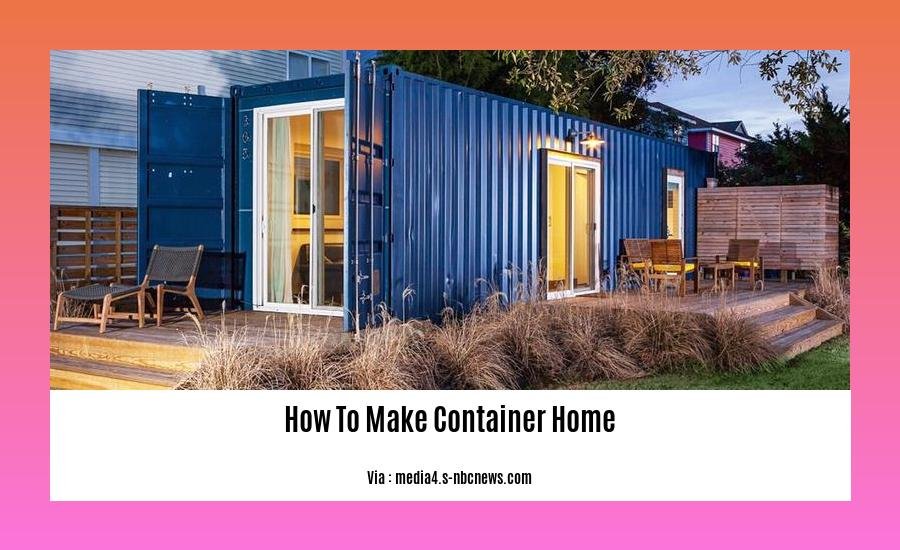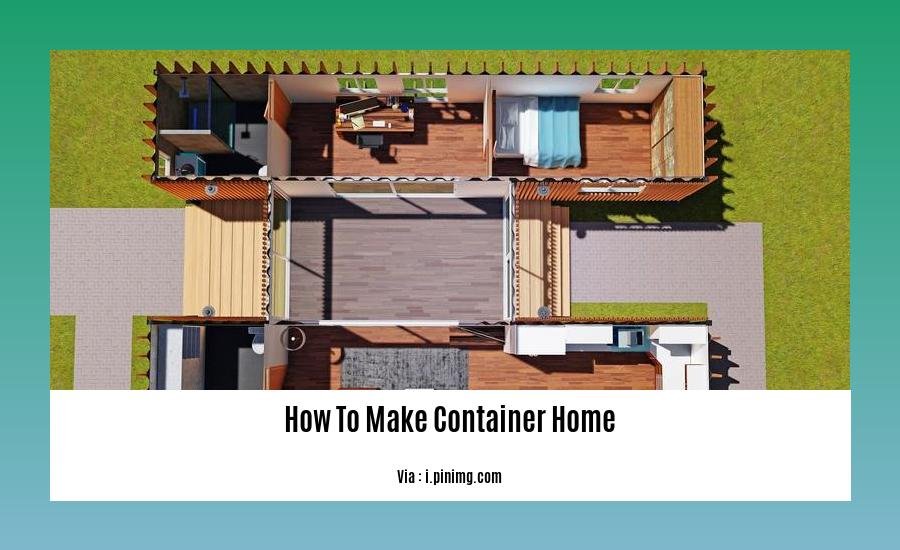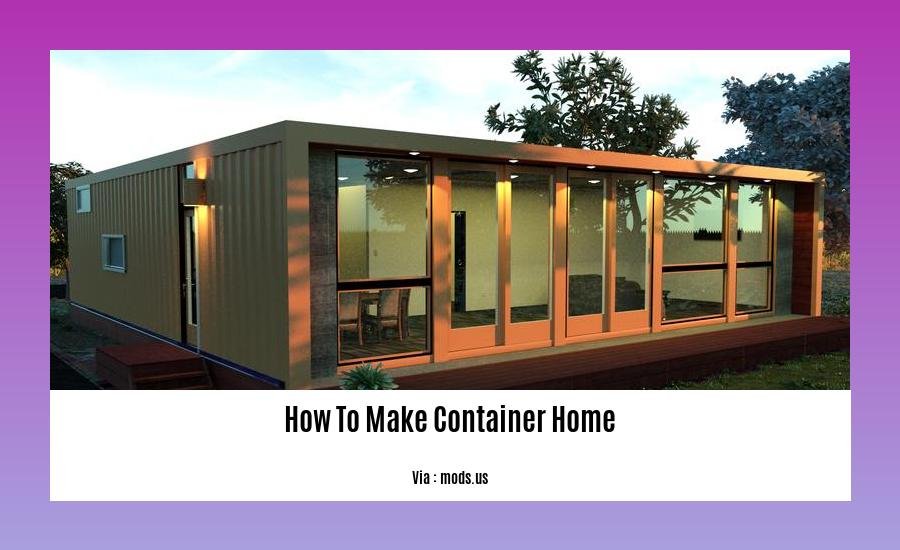Delve into the world of sustainable living with our comprehensive guide, [How to Make a Container Home: A Step-by-Step Guide for Sustainable Living]. Learn the art of transforming recycled shipping containers into cozy and eco-friendly dwellings, reducing your environmental footprint while embracing a unique lifestyle.
Key Takeaways:
- Plan Ahead:
- Research local building codes and zoning regulations to ensure container homes are permitted in your area.
- Secure the necessary building permit before starting construction.
-
Create a detailed budget and design plan for your container home.
-
Prepare the Site:
- Level the ground and clear any debris from the construction site.
- Install utilities such as water, sewer, and electricity to the site.
-
Secure the foundation of your container home according to local building codes.
-
Build Your Container Home:
- Place the shipping containers on the foundation and connect them using steel beams and welding.
- Construct walls, roof, and other structural elements using materials like metal panels, wood, or concrete.
- Install electrical wiring, plumbing, HVAC systems, and insulation.
-
Build interior walls, partitions, flooring, windows, doors, cabinets, and fixtures.
-
Add Finishing Touches:
- Apply paint, wallpaper, and other finishes to the interior and exterior of your container home.
-
Install outdoor elements like decks, patios, and landscaping to enhance the aesthetics and functionality.
-
Additional Points:
- Container homes offer benefits like durability, low maintenance, cost-effectiveness, and eco-friendliness.
- Challenges include obtaining permits, potential zoning restrictions, limited space, and the need for specialized skills or contractors.
- Construction time varies depending on the project’s size and complexity, but it’s often faster than traditional methods.
How to Make a Container Home: A Comprehensive Guide

Transforming shipping containers into sustainable and eco-friendly homes is a captivating concept, merging innovation and sustainability. Embark on this transformative journey by following a step-by-step guide:
-
Laying the Foundation:
-
Choose Your Location Wisely:
- Opt for an area that aligns with your desired lifestyle and offers proximity to essential amenities.
-
Secure Building Permits:
- Research local regulations, zoning restrictions, and building codes to ensure the legality of your container home.
-
Budget, Design, and Imagination:
-
Create a Detailed Budget:
- Meticulously account for expenses, encompassing container acquisition, materials, labor, and permits.
-
Let Your Design Creativity Soar:
- Sketch your dream layout, considering room configuration and modifications like windows and insulation.
-
Shipping Containers: The Core of Your Home:
-
Acquiring the Containers:
- Opt for sturdy and well-maintained shipping containers, carefully assessing their condition.
-
Positioning and Assembly:
- Place containers strategically on your prepared site, interconnecting them with steel beams for stability.
-
Interior Build-Out: Transforming the Space:
-
Rough-In and Infrastructure Setup:
- Install electrical wiring, plumbing systems, HVAC, and insulation, ensuring functionality and comfort.
-
Interior Design and Construction:
- Craft interior walls, partitions, and flooring, harmonizing aesthetics with practicality.
-
Finishing Touches:
- Add windows, doors, cabinetry, and fixtures, personalizing your container home’s interior.
-
Embracing Energy Efficiency:
-
Harness Solar Power:
- Install solar panels to harness clean, renewable energy, reducing your carbon footprint.
-
Embrace Natural Light:
- Maximize natural light by incorporating ample windows strategically positioned for optimal illumination.
-
Insulate Wisely:
- Utilize high-quality insulation to minimize energy loss, ensuring year-round comfort and cost savings.
-
Outdoor Oasis: Extending Your Living Space:
-
Deck or Patio Creation:
- Construct a deck or patio, extending your living area outdoors and creating a seamless indoor-outdoor connection.
-
Landscaping Magic:
- Create a harmonious landscape, integrating native plants and sustainable gardening practices.
-
Maintenance and Sustainability: A Long-Term Commitment:
-
Regular Inspections:
- Conduct routine inspections to promptly address any issues, ensuring the longevity of your container home.
-
Eco-Friendly Lifestyle:
- Embrace an eco-friendly lifestyle, reducing your environmental impact through recycling, composting, and conscious consumption.
Step into the world of sustainable living by creating your dream container home. Blend innovation with sustainability and relish the satisfaction of inhabiting a unique and environmentally responsible abode.
- Exploring the Cost of Modular Homes: Discover How Much a Modular Home Really Costs how much does a modular home cost.
- Learn How to Build Your Own Container Home: Dive Into the Exciting World of Container Home Construction how to build a container home.
- Uncover the Secrets of Moving a Mobile Home for Free: Save Money and Effort with Ingenious Techniques how to move a mobile home for free.
- Selling Your Mobile Home? Master the Art of Selling a Mobile Home: Strategies and Tips for a Successful Sale how to sell a mobile home.
- Take Control of Your Sale: Learn How to Sell a Mobile Home By Owner and Maximize Your Profit how to sell a mobile home by owner.
Modify and Join Containers

Modifying and joining containers is a crucial aspect of building a shipping container home. It encompasses various techniques to transform standard shipping containers into habitable living spaces. Let’s delve into the process:
Steps:
- Assess and Prepare:
- Carefully inspect the containers for any damage or structural issues.
-
Measure and mark the areas where modifications are necessary, such as openings for windows, doors, and skylights.
-
Cutting and Reinforcing:
- Use specialized tools to precisely cut openings for windows, doors, and skylights.
- Reinforce the container’s structure around the openings to maintain its integrity.
-
Consider adding additional support beams if needed.
-
Insulation and Wiring:
- Install insulation material to regulate temperature and enhance energy efficiency.
-
Run electrical wiring, plumbing systems, and ventilation ducts through the containers.
-
Joining Containers:
- Position the containers according to your desired layout.
- Secure the containers together using welding, bolts, or specialized connectors.
-
Ensure that the containers are level and stable.
-
Finishing Touches:
- Apply paint or other finishes to the exterior and interior of the containers.
- Install windows, doors, and skylights.
- Add interior walls, partitions, and flooring to create a functional living space.
Tips:
-
Hire Professionals: If you lack the necessary skills or experience, consider hiring qualified professionals for container modification and joining.
-
Consider Aesthetics: While functionality is crucial, don’t overlook the aesthetic appeal of your container home. Choose colors and finishes that complement each other.
-
Maximize Natural Light: Strategically place windows and skylights to bring in natural light and create a spacious feel.
-
Adequate Ventilation: Ensure proper ventilation to maintain a comfortable indoor environment and prevent moisture buildup.
Key Takeaways:
- Modify and Join Containers: Modify containers by cutting openings, reinforcing structures, and installing insulation and wiring. Securely join containers to create a stable structure.
Citations:
-
How to Build a Shipping Container Home: A Complete Guide
Insulate and Install Utilities
Hey there, folks! Welcome back to our container home-building journey. Let’s dive into the crucial step of insulating and installing utilities in your shipping container abode, ensuring comfort and functionality.
Key Takeaways:
- Insulation:
- Choose suitable insulation materials like spray foam, recycled denim cotton, or spray-on insulation for effective coverage.
- Consider factors like climate, budget, and desired insulation value when making your choice.
- Utility Installation:
- Engage licensed professionals for electrical wiring, plumbing systems, HVAC, and insulation installation.
- Prioritize safety and code compliance throughout the process.
- Insulation Tips:
- Combine spray-on insulation with ceramic insulation paint for exterior protection.
- Ensure insulation methods don’t promote corrosion or condensation.
1. Insulation:
Ah, insulation – the secret ingredient to a cozy and energy-efficient container home. Let’s explore some top choices:
- Spray foam insulation: This one’s a popular pick, known for its easy application and ability to seal those pesky cracks and crevices.
- Recycled denim cotton insulation: Eco-friendly and sustainable, recycled denim cotton insulation offers similar performance to traditional fiberglass insulation without the nasty handling risks.
- Spray-on insulation: This is a great option for container homes because it provides continuous coverage, and when combined with ceramic insulation paint, you’ll have exterior protection too.
Before you jump in, consider factors like your climate, budget, and desired insulation value. These will help you make the best choice for your container home.
2. Utility Installation:
Time to bring your container home to life with essential utilities! Here, it’s crucial to engage licensed professionals for electrical wiring, plumbing systems, HVAC, and insulation installation. Safety and code compliance are paramount, so don’t attempt these tasks yourself unless you’re a certified expert.
3. Tips for Insulating Your Container Home:
Let’s uncover some insider tips for effective insulation:
- Combine spray-on insulation with ceramic insulation paint: This dynamic duo provides comprehensive insulation and exterior protection.
- Avoid insulation methods that promote corrosion or condensation: Traditional insulation methods may not be suitable for container homes. Choose options that are corrosion-proof and minimize condensation risk.
With these tips in mind, you’ll be well on your way to creating a comfortable and sustainable container home.
Conclusion
And there you have it, folks! Insulating and installing utilities in your container home is a crucial step towards a cozy and functional living space. Remember, safety and code compliance are non-negotiable, so engage professionals where necessary. In our next segment, we’ll explore the art of crafting interior walls and partitions, transforming your container home into a stylish and comfortable haven. Stay tuned!
Additional Sources:
- 5 Tips For Insulating A Shipping Container
- How to Insulate a Shipping Container Home – 9 Best Options
Finishing Touches
Hello there! So, you’ve embarked on the incredible journey of creating your own container home. Congratulations! You’re almost there. Now, let’s focus on the final touches that will transform your humble container into a comfortable and stylish living space.
Key Takeaways:
- Design with Intention: Consider your color palette and décor style to create a cohesive and inviting interior.
- Accessorize Wisely: Add rugs, curtains, and plants to bring warmth and personality to your space.
- Furniture with a Purpose: Choose furniture that maximizes space and reflects your personal style.
- Light It Up: Layer your lighting to create a warm and inviting ambiance.
- Art and Decor: Display art, photographs, and other decorative items that tell your story.
- Outdoor Oasis: If space allows, create an outdoor living area with seating and potted plants.
1. Design with a Vision
Before you start shopping for furniture and accessories, take a moment to envision your ideal living space. What colors and textures resonate with you? Do you prefer a minimalist aesthetic or a cozy, eclectic vibe? Having a clear design direction will help you make cohesive choices.
2. Accessorize Wisely
Rugs, curtains, and plants are your best friends when it comes to adding warmth and personality to your container home. Choose rugs that define different areas of your living space and curtains that filter light while adding privacy. Plants not only bring a touch of nature indoors but also improve air quality.
3. Furniture with a Purpose
In a container home, every inch of space matters. Opt for furniture that serves multiple purposes, such as a sofa that converts into a bed or a coffee table with hidden storage. Built-in furniture can also be a great way to maximize space and create a sleek, modern look.
4. Light It Up
Lighting can make or break the ambiance of your container home. Layer your lighting by combining overhead lights with task lighting and accent lighting. Consider using dimmer switches to adjust the brightness and create different moods throughout the day.
5. Art and Decor
Your home should reflect your personality and style. Display art, photographs, and other decorative items that tell your story and spark joy. A few well-chosen pieces can transform an ordinary space into a welcoming and inviting haven.
6. Outdoor Oasis
If your container home has outdoor space, take advantage of it! Create a cozy seating area with comfortable chairs and cushions. Add some potted plants and string lights to create a warm and inviting ambiance. Even a small outdoor space can be a great place to relax and unwind.
Relevant URL Sources:
- 12 Simple Steps to Building Your Shipping Container Home
- How to Build a Shipping Container Home: A Complete Guide
FAQ
Q1: What are the key steps to building a shipping container home?
A1: The key steps involve finding your location and securing building permits, finalizing your budget and design, placing the containers and starting construction, performing interior rough-in and build-out, and adding final touches to complete the home.
Q2: What are the advantages of building a shipping container home?
A2: Shipping container homes offer benefits such as durability, low maintenance, cost-effectiveness, and eco-friendliness, contributing to sustainable living.
Q3: Are there any challenges associated with building a shipping container home?
A3: Challenges in building a container home may include obtaining building permits, potential zoning restrictions, limited space, and the need for specialized skills or contractors.
Q4: What are the recommended insulation materials for shipping container homes?
A4: Popular insulation options include spray foam insulation for its easy application and coverage, recycled denim cotton insulation for its sustainability and low handling risk, and spray-on insulation like polyurethane foam, often combined with ceramic insulation paint for exterior protection.
Q5: What are the steps for preparing the shipping container home foundation?
A5: Preparing the foundation involves creating a solid foundation to support the weight of the shipping containers, which can be done using concrete slabs, piers, or screw piles.
- Small Corner Kitchen Ideas: Maximize Style In Tight Spaces - January 1, 2026
- Kitchen Counter Corner Ideas: Style Your Awkward Angles Now - December 31, 2025
- Best Finish for Butcher Block Countertops: Choosing the Right Option - December 30, 2025










